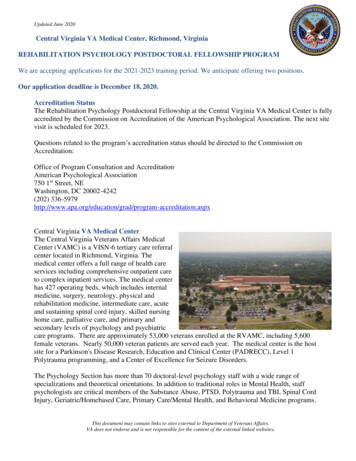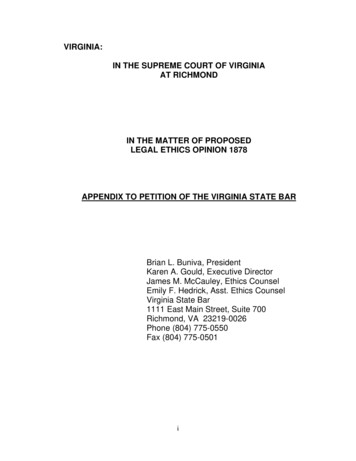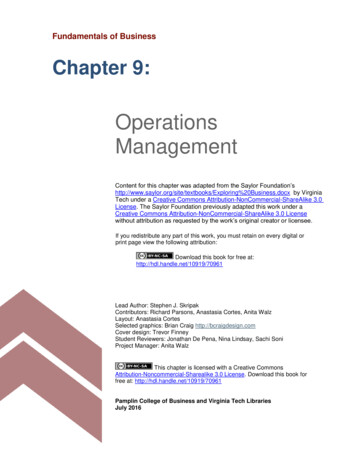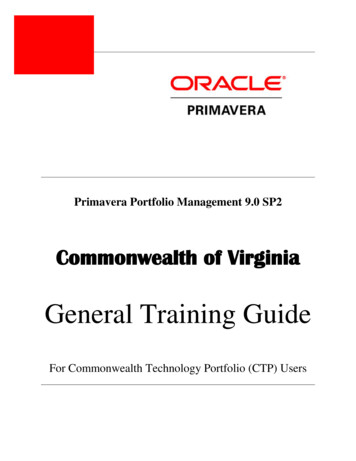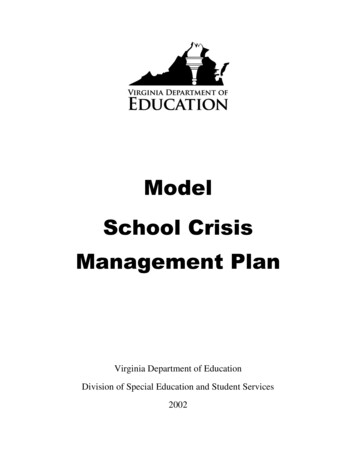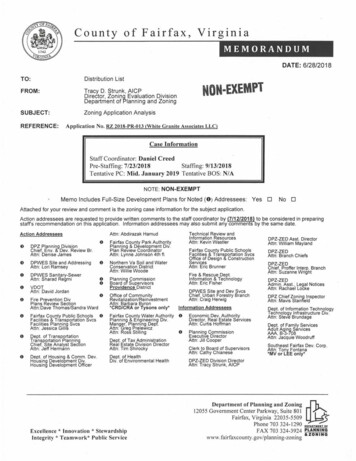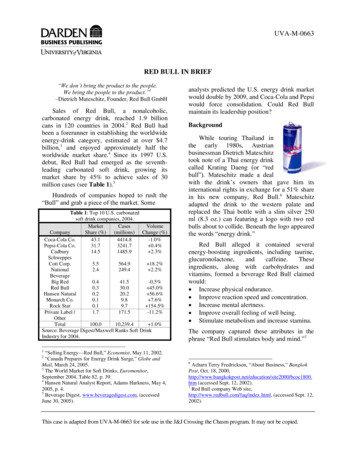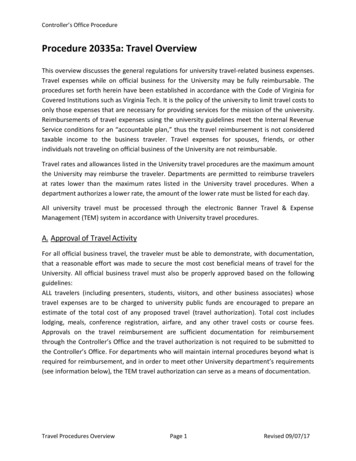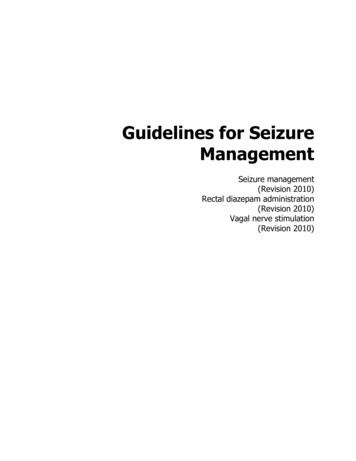
Transcription
Guidelines for SeizureManagementSeizure management(Revision 2010)Rectal diazepam administration(Revision 2010)Vagal nerve stimulation(Revision 2010)
Seizure ManagementOverviewA seizure is an event in which there is a temporary change in behavior resulting from asudden, abnormal burst of electrical activity in the brain. If the electrical disturbance islimited to only one area of the brain, then the result is a partial seizure. For example, thestudent may experience confusion, loss of awareness, aimless movements, or uncontrolledbody movements. If the electrical disturbance affects the entire brain, the result is ageneralized seizure.Epilepsy or a seizure disorder is a chronic condition that is characterized by recurrentseizures. Many students with epilepsy have more than one seizure type and may have othersymptoms as well.Some seizures may result from an acute medical illness (e.g., with a diabetic during ahypoglycemic episode) or an acute injury (e.g., head injury) and cease once the illness istreated. Some children may have one seizure without the cause ever being known.Classification of SeizuresThe following table summarizes the classification of seizures:Generalized SeizuresTonic-clonic seizures(formerly known as grandmal seizures; affects theentire brain)Onset: any ageAbsence seizures(formerly called petit malseizures, “lapses,” or“staring spells”)Onset: age 4-12Clinical ManifestationsThe eyes roll upward, the student loses consciousness,falls to the ground, and becomes rigid as muscles tighten(tonic phase).This is followed by jerking movements of the entire bodyas muscles undergo rhythmic tightening and relaxation(clonic phase). During this phase, the student maybecome incontinent of stool and urine as his/her musclescontract and relax. Breathing may be shallow or even stopbriefly, but renews as jerking movements end.Generalized seizures usually last 1-2 minutes. After thetonic-clonic phase, movement slows and is followed bydrowsiness or deep sleep that can last several hours(postictal state).These seizures are characterized by a brief loss ofconsciousness with minimal or no alteration in muscletone and sometimes go unrecognized. The seizures can bemistaken for daydreaming or inattentiveness.Students may:Simply stare blankly for 5-10 secondsDrop objects because of loss of muscle toneHave minor movements such as lip-smackingExperience twitching or slight hand movementsThe student will be unable to recall what happened duringthese brief periods of “blankness.” If untreated, seizures
Generalized SeizuresAtonic seizures(also known as drop attack)Onset: age 2-5Myoclonic seizuresPartial SeizuresSimple Partial Seizures(focal seizures; affects justone part of the brain)Onset: any ageComplex Partial Seizures(psychomotor seizures)Onset: age 3and upClinical Manifestationsmay occur many times a day.Seizures can be precipitated by fatigue, stress,hypoglycemia, or hyperventilation.Manifested as a sudden, momentary loss of motor tone.The student may or may not lose consciousness.A mild atonic seizure may cause a sudden, brief headdrop. During a more severe atonic seizure, the studentmay suddenly fall to the ground, lose consciousnessbriefly, and then get up as if nothing happened. If astudent has frequent atonic seizures, a helmet is worn toprevent injury to the head or face.Characterized by sudden, brief contractures of a muscle orgroup of muscles without loss of consciousness.No postictal state.Clinical ManifestationsManifestations are dependent on the area affected and tendto be localized. The student may, or may not, loseconsciousness and may be aware of the seizure. Forexample, a student’s eyes or eyes and head turn to oneside and the arm on that side may be extended with thefingers clenched. The student may appear to be lookingtoward the closed fist.It is important for an eyewitness to give a clear descriptionof the seizure, especially which body parts are initiallyinvolved, to aid in diagnosis and treatment. Also, notingthe circumstances that precipitated the episode can help intreatment.Students may also experience a postictal stage after apartial seizure. Simple partial seizures may spread andbecome generalized. Consciousness is never impaired.The most common type of seizures. These seizures oftenbegin with an aura or warning that the seizure is about tooccur. Most commonly, the aura is described as a strangefeeling in the pit of his/her stomach that rises up to thethroat. Often this sensation is accompanied by odd orunpleasant odors or tastes, auditory or visualhallucinations, or feelings of elation or strangeness.A student may cry or run for help. During this time, thestudent is often unaware of his/her environment andunable to respond to the environment.After the aura, the student may suddenly become limp orstiff, appear dazed, and confused and apathetic. The mostobvious behaviors may be lip smacking, repeating words,
Partial SeizuresClinical Manifestationschewing, drooling, swallowing, and nausea and abdominalpain followed by stiffness, a fall, and sleep.Complex partial seizures may spread and becomegeneralized. Consciousness is always impaired.Potential SettingsMany students with a history of seizures attend a regular classroom and participate in regularschool activities, with modifications that are determined by the parents, health care provider,school nurse, and school staff. As with all medical conditions, every effort is made to protectthe student’s privacy, especially during the occurrence of a seizure. School personnel havingcontact with the student are to be familiar with the student’s medications and potential sideeffects, be able to recognize signs of seizure-related behavior, know what to do when signsare observed, and know how to implement the established school emergency plan.Medications Currently Used to Treat Seizures (this list includes only a sample ofmedications available to treat seizures) Additional medications to treat seizures maybecome available for use in the U.S.A. as approved by the FDA and prescribed by themedical care provider.Generic NameCarbamazepineTrade NameTegretolSeizure TypeSecondary tonic/clonicComplex partialSimple nicEthosuximideZarontinAbsenceFelbamate—usedonly with cautionand informedconsent due toserious adversereactionsGabapentinFelbatolPartial andgeneralized (reservedfor severe epilepsy)NeurontinPartial, patients 12yearsAdverse ReactionsAllergic reactions,dizziness, ataxia, muscleincoordination, nausea,behavioral changes, blurredor double vision, aplasticanemia, hepatitisSedation, hyperactivity,aggressiveness, slurredspeech, double vision,behavior changes, increasedsalivationGI upset, loss of appetite,headache, lethargy, behaviorchanges, dizziness, dystonia,myelosuppression, druginduced lupusAplastic anemia, hepaticfailure, anorexia, weightloss, nausea, insomnia,headache, fatigueSomnolence, dizziness,ataxia, fatigue
Generic NameLacosamideTrade NameVimpatSeizure ex partialSimple nic-clonicComplex partialSimple partialRufinamideBanzelLennox-GastautSyndrome (also knownas opiramateTopamaxValproateValproic onicAbsenceMyoclonicAbsenceTonic-clonicAdverse ReactionsDizziness, headache,nausea, double visionSomnolence, dizziness, rash,nauseaSedation, hyperactivity,changes in sleep pattern,inattention, irritability,cognitive impairmentGingival hyperplasia,hirsutism, nystagmus,blurred or double vision,ataxia, rashes, folatedeficiency, drug-inducedlupus, myelosuppressionBlurry vision, dizziness, drymouth, weight gain,sleepiness, swelling ofhands and feet, troubleconcentratingSedation, hyperactivity,ataxia, behavior changes,rare hematological andhypersensitivity reactionsAllergic reactions,dizziness, drowsiness,headache, nausea, tiredness,vomiting, appetite changes,sore throat, blurred vision,tremor, blood in urine;behavior, mental, moodchanges, trouble sleeping,suicidal thoughts or attemptsDizziness, somnolence,headache, depressionSomnolence, anorexia,fatigue, difficulty withconcentration, nervousnessHair loss, tremor, elevatedliver enzymes and liverfailure, irregular menses,
Generic NameTrade NameSeizure TypeMixed seizures typesAdverse Reactionsincreased appetite, nauseaand vomiting, pancreatitisthrombocytopeniaDiet TherapyIn specific cases, students with seizures may be prescribed a ketogenic diet for treatment andcontrol of seizures. Usually this diet is prescribed for students with poorly controlledseizures who cannot tolerate the side effects of anticonvulsants.The ketogenic diet is designed to induce and maintain a state of ketosis which has been foundto metabolically improve seizure control in certain cases. The diet is high in fat (80-90%)and low in carbohydrates and proteins. It is a carefully calculated diet and requires dailymonitoring to maintain ketosis. A student on a ketogenic diet is followed by a registereddietitian and has a prescribed meal plan to follow daily. Coordination between the student’sneurologist, dietitian, family, and school is recommended for the development of a successfulindividualized health care plan (IHCP).MonitoringThe purpose of seizure monitoring is to protect the student from injury during a seizure, tocarefully observe the seizure in order to provide information for the management of theseizure disorder, and to distinguish between behaviors related to a seizure and thosebehaviors not related to it.Monitoring provides the health care provider with the information needed to better managethe student’s medication. An increase in the number of seizures may indicate that the studentneeds a change in medication or that he/she is not receiving the prescribed medication. Achange in medication may be needed because of a change in the student’s metabolism. Inaddition, antiepileptic medication may be toxic. Therefore, any side effects from themedication should be documented and reported to the school nurse, family, and/or healthcare provider. Careful monitoring of the student can improve the management of seizures.Signs of an EmergencyA series of consecutive seizures in which the student does not regain consciousness is calledstatus epilepticus, which is a medical emergency. Immediate medical care is required.Seizures that last longer than 5 minutes require emergency medical services. Seizureslasting longer than 30 minutes can cause brain damage. Status epilepticus can lead torespiratory failure, brain damage, and death. Therefore, it is critical that the student receiveimmediate medical attention.Managing a SeizureManaging a seizure in school consists of protecting the student, observing the student, andgetting medical assistance when needed. The procedures on the following pages areguidelines for managing a student having a seizure and what to do after the student has aseizure. Included in the guidelines is the First Aid Flow Chart for Seizures algorithm (seepage 165).
Components of the Individualized Health Care Plan (IHCP)Each student’s IHCP must be tailored to the individual’s needs. The following section coversthe procedure for managing a seizure and possible problems and emergencies that may arise.It is essential to review it before writing the IHCP.Note: Equipment, medication, and supplies are provided by the parents/guardians.A sample seizure action plan and seizure observation record (or seizure log) areavailable from als/.For a student with seizures, the following items should receive particular attention:Student’s underlying condition and possible problems associated with the conditionor treatment.Type of seizures student experiences and typical course of seizure.Student’s baseline or normal behaviors.Whether student experiences auras, or can anticipate when seizures may occur.Behaviors that indicate a seizure may be about to occur.Actions to take if the student has a seizure.Medications the student is taking, including rescue treatments, and signs of adversereactions or toxicity.Determining the need for seizure precautions, and what these precautions will be.Latex allergy alert.Standard precautions.Additional resources and supplementary materials for managing students with seizures areavailable at urse/schoolnurse.cfm.Sources:Drugs.com. (2000-2010). Banzel. Available online at http://www.drugs.com.Epilepsy Foundation of America. Available online at http://www.epilepsyfoundation.org.Epilepsy Foundation of America. (2008) Seizure Training for School Personnel. Available y, M.J. & Wilson, D. (2007). Wong’s Nursing Care of Infants and Children. (8thed.). St. Louis:Mosby, pp. 1652-1669.Physician Desk Reference Consumer Drug Information. (2000-2010). Available online athttp://www.drugs.com/pdr/.Vimpat.com. (2009). Vimpat. Available online at http://www.vimpat.com.
Procedure for Managing a SeizureIf the student has a seizure:1. Remain calm.No one can stop a seizure once it starts.2. Time the seizure. Document all of the student’s activity during a seizure: the time seizurebegan, the time seizure ended, area of body where the seizure began, any movement ofthe seizure from one area of the body to another, type of movements of the head, face,and/or arms.3. Check for medical alert I.D. and follow the student’s individualized health care plan(IHCP).If applicable, provide seizure rescue treatment.4. Have an adult stay with the student during the seizure to monitor his/her progress.5. Put on gloves, if available.6. Place student on side. If possible, put something flat and soft (like a folded bl
individualized health care plan (IHCP). Monitoring The purpose of seizure monitoring is to protect the student from injury during a seizure, to carefully observe the seizure in order to provide information for the management of the seizure disorder, and to distinguish between behaviors related to a seizure and those behaviors not related to it.
